|
Matrix Algebra - Cellular matrices
Cellular matrices
Let's consider some matrix
A
and we’ll split it into matrices of lower order:
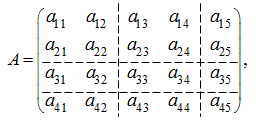
which are called
cells
or
blocks
.
Here cells (blocks) are matrices:
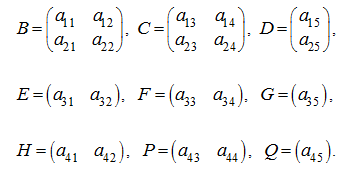
Now the matrix
A
can be considered as
cellular
or
block
matrix:

which elements are cells (blocks).
Apparently, that splitting of any matrix into cells (blocks) is maybe executed by various ways. In that specific case the cellular matrix can be quasi-diagonal one:
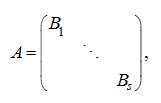
where cells
 – square matrices (generally speaking, of different orders), and outside of cells zeros are. Note, that
– square matrices (generally speaking, of different orders), and outside of cells zeros are. Note, that

Cellular matrices of the same dimensions and with identical splitting are called
conform
.
Operations with cellular matrices are carried out by the same rules, as with usual matrices.
1. Addition and subtraction of cellular matrices
Let there are two conform cellular matrices:

where
p = r
,
q = s
and cells
 of identical dimension. Then
of identical dimension. Then

Subtraction of cellular matrices is carried out similarly.
2. Multiplication of cellular matrices
Multiplication of a cellular matrix to a number (scalar)
Let
A
– a cellular matrix and
h
– a number, then we have:
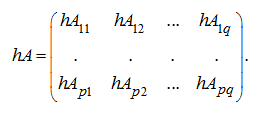
Multiplication of cellular matrices
Let's consider two conform cellular matrices:

and
q = r
.
Let all cells
 such, that a number of columns of a cell
such, that a number of columns of a cell
 is equal to a number of rows of a cell
is equal to a number of rows of a cell
 (For example, apparently, that it takes place in that specific case, when all cells
(For example, apparently, that it takes place in that specific case, when all cells
 – square matrices and have also the same order). Then it is easy to show, that a product of matrices
A
and
B
is too a cellular matrix:
– square matrices and have also the same order). Then it is easy to show, that a product of matrices
A
and
B
is too a cellular matrix:
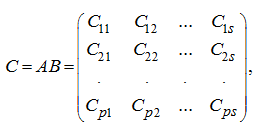
where
 that is
multiplication of cellular matrices is similar to multiplication of numerical
matrices
[2].
that is
multiplication of cellular matrices is similar to multiplication of numerical
matrices
[2].
E x a m p l e . Multiply the cellular matrices

S o l u t i o n .
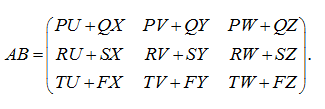
|









